The Spider Awards: Three Awards (3rd Place, Two Honorable Mentions)
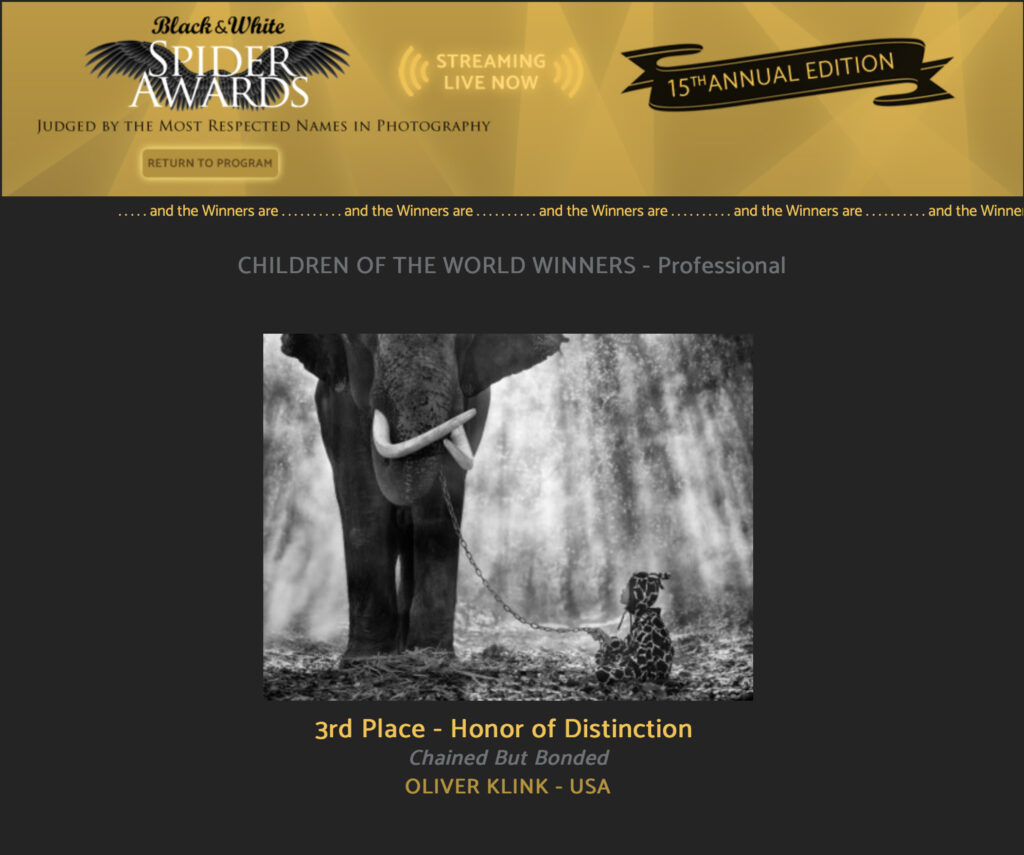
The Black and White Spider Awards is the contest judged by the most respected names in photography. I am proud of announcing that three of my images were selected for awards in the 15th Annual award.
Chained but Bonded was photographed in Thailand (February 2020). This is a powerful image for its content and execution. You can read more about the on-going project about elephants at https://blog.oliverklinkphotography.com/Views-of-Elephants
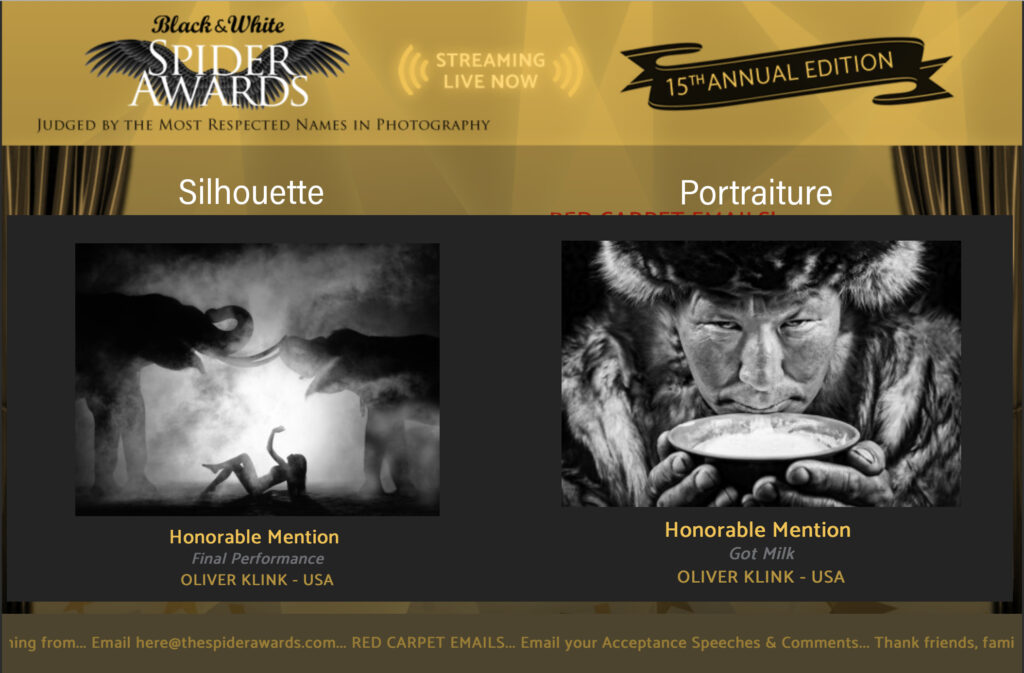
I received two honorable mentions in the Silhouette and Portraiture categories. “Get Milk” is part of a 15 year project that lead to the publication of the award winning book, Cultures in Transition. The book received 9 awards for best photography book of 2019! More info.
Congratulations to all the winning photographers. It is a privilege to be part of such a group of inspiring Black and White photographers!
Staying Creative during Covid 19
https://roblyimages.s3.amazonaws.com/accounts/9176/pdf/2090205.pdf
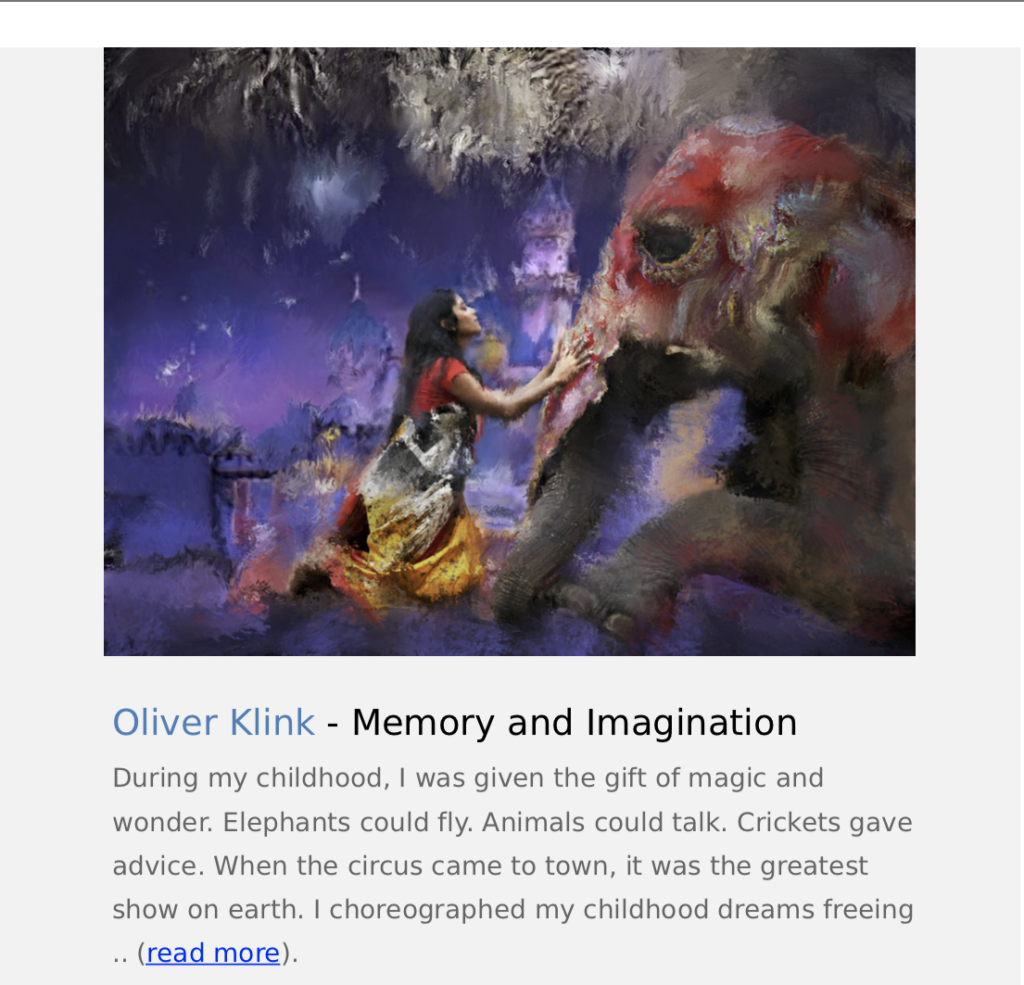
Photographer Pledge Support
https://roblyimages.s3.amazonaws.com/accounts/9176/pdf/2060774.pdf
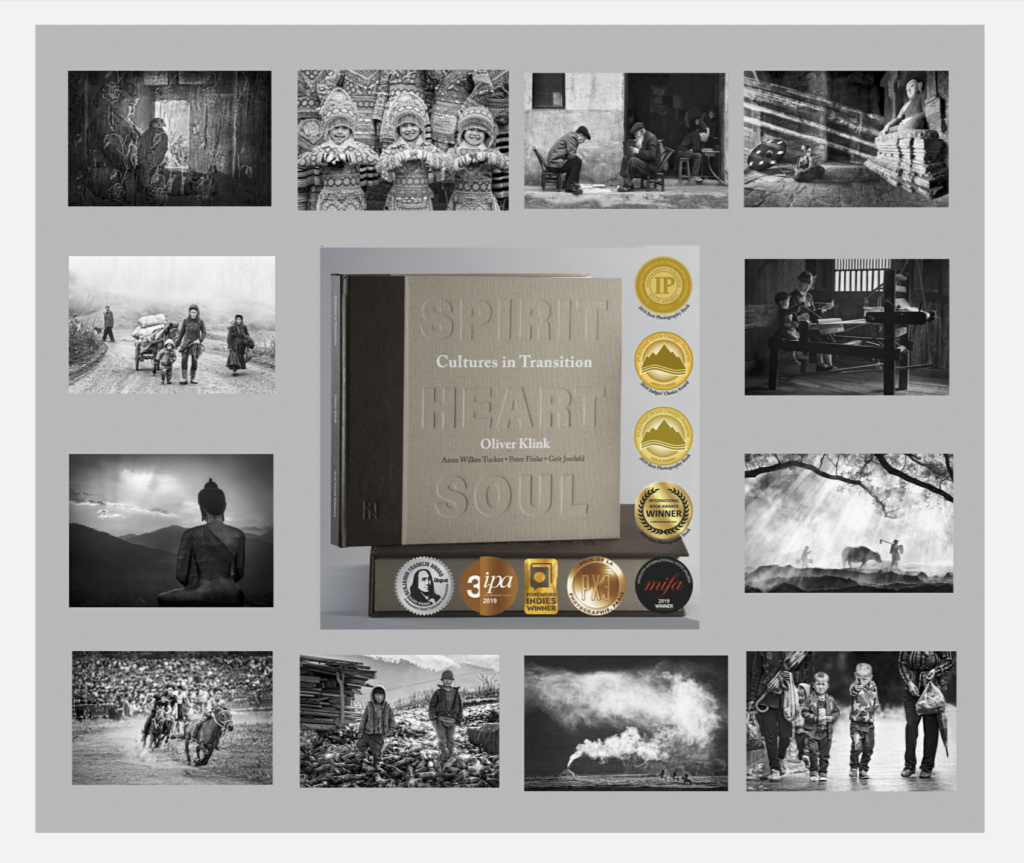
Ninth Award: Cultures in Transition is honored at the IBPA Award (Benjamin Franklin).
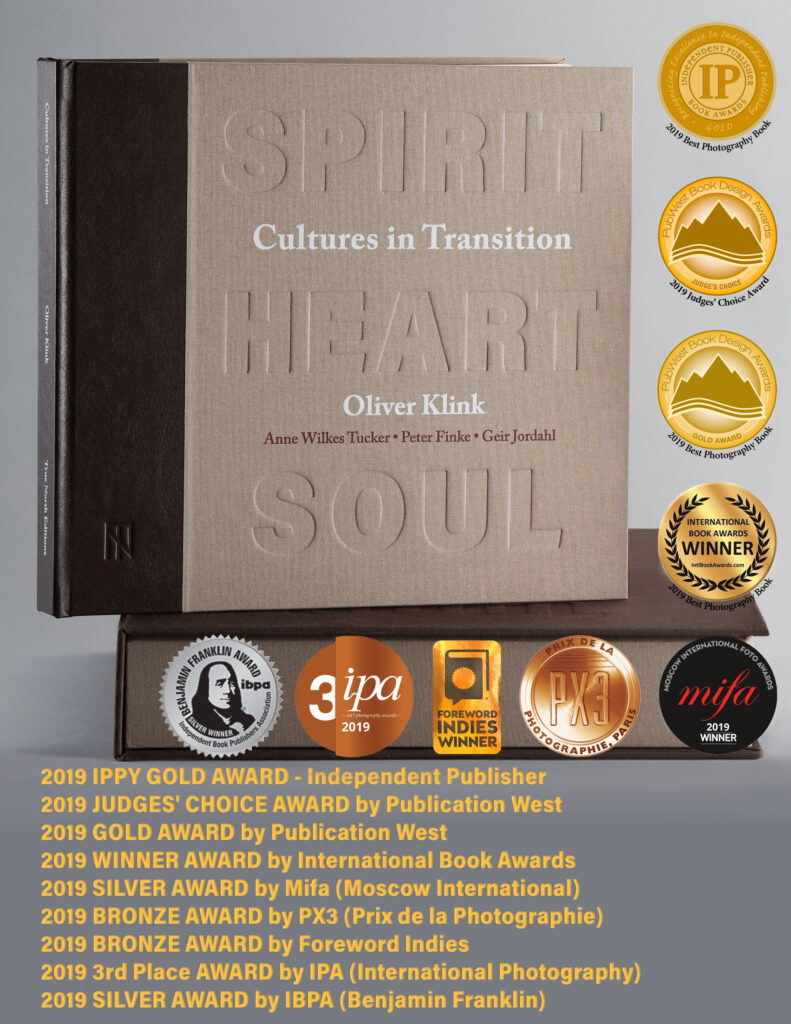
May 7, 2020 – Press Release
What an exciting news: Cultures in Transition book receives its NINTH Award for best photography book of 2019!!!
From Geir & Kate Jordahl – True North Edition Publisher.
Intimate relationships, a shared unified vision and high standards from the entire creative team made Cultures in Transition a labor of love and dedication. The goal to create a product to be experienced fully with all the senses – a book that looks beautiful, feels sensual and smells good using tactile cloth and paper, dimensional binding, images that engage the emotions and text that stimulates the mind – all this is possible when investments are shared toward a common goal – a book that changes lives. Our press in Italy Longo AG was on board to print a “flagship” Photobook. We lived on press all week, the Longo crew worked in hand with artist, publisher and designer. Spoken language limitations were overcome by the universal voice of image and art! The same was true at Legatoria bindery where the owner, Alexandro and our representative Giuseppe, discussed in Italian for what seemed to be an eternity, the feasibility of our vision’s successful execution. In the end, again, the intimate shared investment in the project and belief in its message made the seemingly impossible succeed! Words emerged in English and Italian: mysterious, long lasting, memorable, BELLISSIMO! Only Indie publishing can create such a project! The world needs Spirit, Heart and Soul now more than ever and working with the teams from True North Editions, Longo AG and Legatoria made this work what it is!
Award Ceremony Acceptance Speech!
Purchase the book at https://www.culturesintransition.com/OrderForm
Black and White Magazine Cover Story (March 2020)
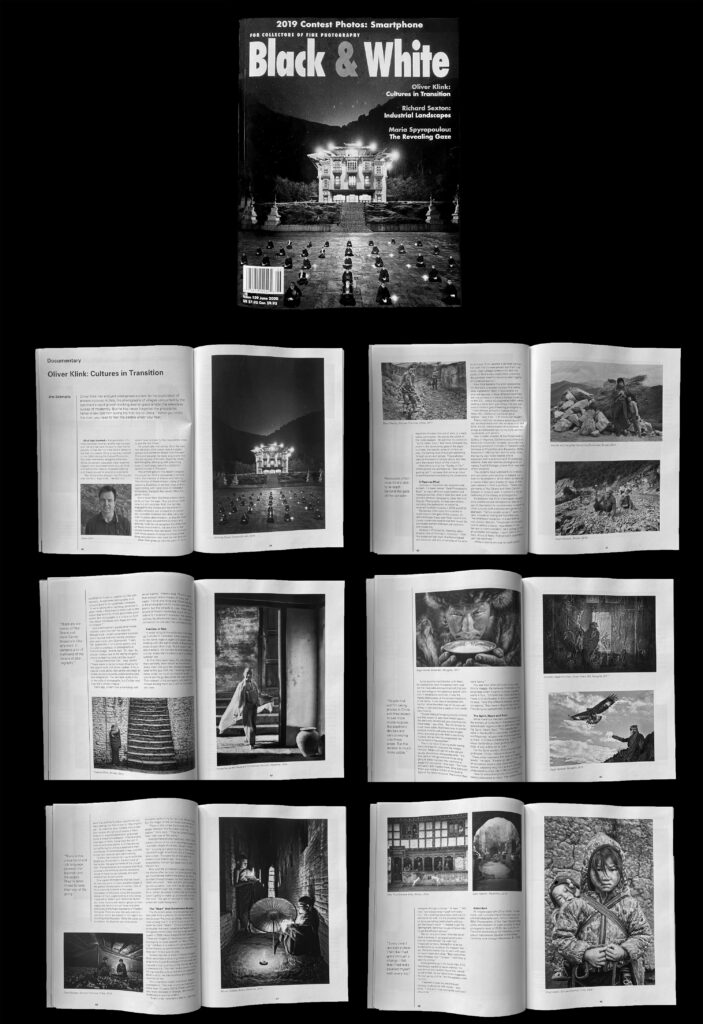
Black and White Magazine can be purchased at https://www.bandwmag.com
THE PEOPLE THAT TIME FORGOT
Oliver Klink’s exploration of ancient cultures in Asia captures the eternal grace that endures against the relentless sweep of modernity.
Oliver Klink would never forget the proverb his father-in-law told him during his first trip to China: “When you cross the river, you need to feel the pebble under your feet.”
Klink had married a first-generation Chinese-American woman, and he had traveled with her and her parents back to their home country. It was the first time Klink’s father-in-law had returned to China since they had left in the 1960s during the Cultural Revolution. The older manhardly recognizes the new China, its densely populated urban expanse clogged with skyscrapers and cars, air thick with pollutants, masses of people walking with heads bowed to smartphone screens.
“My father-in-law thought that China grew way too fast,” says Klink. “He told me I would have to travel further beyond the cities to see the real China.”
He would take that advice. Over the next two decades, Klink would carry his digital camera and penetrate deeper into Western China and beyond. He made excursions into remote regions of Bhutan, Myanmar, India, and Mongolia, emerging with a stunning body of work organized in a collection called Cultures in Transition.
This almost generic title doesn’t prepare the viewer for Klink’s transcendent achievement, the mastery of shadow and framing. The intimacy of these images, many of them capturing Buddhists in somber ritual and villagers toiling with rustic tools in forbidden landscapes, transport the viewer into a forgotten world.
But it never feels like these photos beckon to us from the past. They are of our own time but still separate. Both the families engaged in rote chores and the monks in mindful reflection are steeped in centuries-old, inviolable traditions that they carry out with ritualistic determination, as the developing world rages around them in chaos and disarray. Even as we recognize the alienness of these environments, we are alive to the shared humanity they represent. We connect with these people in recognition that something very precious may soon be lost forever.
What Klink gives us with his work is not a depiction of a lost tribe out of time or a backwards community. He rejects the cliché of the noble peasant. He subtitles his collection, “Spirit, Heart, Soul,” and these concepts resonate in the penetrating gaze of the eagle huntress, the beatific smile of children at play, the bathing rays of sunlight cascading through an ancient temple. These photos capture moments of simple labors, but they carry the vibrant thrum of the uncanny.
Klink refers to it as the “fluidity of life,” where people are animated by “their spiritual guiding light”—phrases that come as close to anything else in describing the unnamable.
A Rigorous Mind
Cultures in Transitionhas received wide acclaim. It’s been named “Best Photography Book” by eight different organizations and media properties. Klink’s work has been published in National Geographic, Daily Mail, Popular Photography, among many others, including this publication. In 2016 and 2018, he received the Spotlight Award by Black and White Magazine.
Reviewers often note Klink’s ability to reach beyond the gaze of the outsider, to demythologize these rural Asian regions to create immersive experiences that reveal the permeable borders between old traditions and modernity.
Writing in Photolucida, Drazenka Jalsic Ernecic says of Cultures in Transition: “With the sustained high level of anthropological and historical skill and universality of his artistic concept, Klink reaches a spiritual connection with the Chinese people and their customs. Clear vintage composition and the purity of Klink’s new modernism underline the common need for humanity and fragility of human existence.”
How Klink became the artist responsible for this work is another mystery that defies easy explanation. Born in Switzerland, he earned degrees in three different countries, earning a masters in physics before traveling to the U.S., where he acquired an MBA while landing a job at tech giant Cisco. He also pursued a lifetime goal of learning photography.
“I took classes at Foothill College but never got a degree,” says Klink. “I’m mostly self-taught,”
Many creatives harness a gnawing anxiety, an impatience with the world as it is. Not Klink. As you would expect of a physicist, he brings a methodical rigor to his craft, combining tenacity with artistry.
Geir Jordahl, director of the PhotoCentral Gallery in Hayward, Calif., has been friends with Klink for more than 15 years, launched the traveling exhibit of Cultures in Transitionand the book at PhotoCentral in December 2018. Founded in 1983 by Geir and his wife, Kate, the facility also holds classes and is equipped with a darkroom and 10 enlarging stations. Kate also teaches photography at nearby Foothill College, where Klink was one of her students.
The Jordahls have watched Klink’s talent and reputation grow as they’ve helped nurture his development. (Klink refers to Geir as a mentor.) Geir says that he sees shades of many of the past masters in Klink’s portfolio. “There are elements of Paul Strand and Henri Cartier-Bresson in Oliver’s work. It contains a lot of hallmarks of the history of photography.”
He believes that Klink’s immigrant experience and his natural introspective nature is part of the reason he can immerse himself in other cultures with a curious and generous approach.
“He’s a people person,” says Jordahl, himself an immigrant from Norway. “He embraces humanity—it’s something that comes naturally. The people he encounters in various cultures, regardless of the barriers to communication, he’s going to find an authentic connection. I don’t care if it’s Asia, Africa, or Mars. That genuine openness can’t be contrived.”
While it seems unusual for a physicist and MBA to master a creative skill like photography, Jordahl sees photography as a uniquely good fit for systematic mindsets.
“If we’re talking about painting, sculpture, or other media, I think there’s more truth to the notion that scientific minds don’t make good artists. But photography is a unique art form that allows individuals with these skillsets to blossom.”
Klink’s achievement speaks of an innate visionary talent that can’t be acquired through study. Jordahl remembers a conversation he once had with the late photographer and curator John Szarkowski.
“I said, ‘Mr. Szarkowski, I run a photo gallery, but my wife’s a professor of photography at Foothill college.’ And he said, ‘Oh, dear. So should I write a note to her saying, congratulations on teaching what can’t be taught?’
“I always remember that,” continues Jordahl. “There needs to be some type of calling for the type of work that Oliver creates. If not a natural innate ability, then at the very least an innate proclivitytowards understanding light and composition. You can learn quite a few of the skills of photography, but it’s that next step that’s almost magical.”
Years ago, Jordahl took a workshop with Ansel Adams.
“Adams said, ‘There’s more than enough sharp images of fuzzy concepts.’ I think one thing that Oliver has done in his photography is to create work that is poetic but the veracity is clear. It has the traditions of historic reportage, but it fits outside of it. He doesn’t represent his subject as victims; he empowers them. He creates a connection to cultures that are not his own.”
Families at Risk
In order to build the collection that made up Cultures in Transition, Klink would return to the same regions again and again, communicating with the same locals in these remote areas to gain their trust. But it wasn’t just about access. He wanted to understand their culture, share their traditions as much as an outsider can.
At first they were wary. He would take their portraits, then return to the area to share them. He said the residents became used to the guy with the “bobbing head” and ready smile, so much so that the locals would ask his guides when he was returning. They relaxed in his company, and soon he moved among them as if part of their everyday lives.
As he become more familiar with them, he realized that what threatened them was not the inexorable encroachment of 21stcentury technology or the rapacious growth common in developing countries. It was the steady deterioration of an ancient institution of the family. It was loss of emotional connection. More than their way of life was vanishing—it felt more like a piece of their world was missing.
“People find out I’m taking photos in China and they expect to see more modernization, the electronic devices and cars crowding into these areas,” says Klink. “But the tension is much more subtle. Everybody lives in a small physical location with easy access to each other, and what grounds them is the family nucleus. But as time has progressed, the family nucleus has exploded.”
This is the result of young adults leaving the rural areas for cities and the modern lifestyle. What’s left behind is the old and young, the children and grandparents.
“It’s two parts of the generational divide struggling to either maintain their traditions or adopt the new world,” he says. “The modernization didn’t bother them. What bothered them was losing a little bit of the guiding light of the family structure. That’s what they were losing.”
You see how often children factor into Klink’s images. He believes that was to his advantage when it came to capturing this world in flux.
“Children are more authentic. There is no artificiality in their movements,” he says. “And this effect is shared, almost contagious. They have a disarming effect. They bring out authenticity in adults as well.”
The Spirit, Heart, & Soul
While there’s a thematic commonality to the entirety of Cultures in Transitions, Klink labeled each region under a different heading: Spirit, Heart, and Soul.
“The people that were in the Buddhist countries, like Bhutan and Myanmar, religion was more important to them. In China and Mongolia it was more about the family as their guiding light. In India, it was a little bit of both.”
For the Spirit section, he concentrated on Bhutan, China, India, and Myanmar.
“These areas represent the spirit of village bonds,” he says. “People go about their way on unmarked streets and unnumbered homes, speaking very little to each other but understanding their role in the community.”
Here he encountered monks and their careful adherence to ritual. The solemn reverence that attends Buddhist ceremonies are ideal settings for Klink’s talents. In “Morning Ritual,” an unearthly glow radiates from a massive temple, as a group of monks in black roles sit in a perfect geometric grid enraptured in prayerful meditation. A flame alights near each of them. Some hold the light in their outstretched palms, as if they are nurturing the soul’s luminous essence in their very hands. It’s a remarkable image, one that brings new rewards upon each viewing.
To Klink, the mystical isn’t confined to the Buddhists. It’s evident in the bent back of the farmer, the gnarled hands of the ploughman. The ceremonies and customs that have survived since antiquity are the connective tissue of these insular cultures, and each moment has its own power.
One aspect of modernity that has found its way into some of these ancient villages is the gradual emancipation of women. One of Klink’s favorite subjects is the eagle huntresses of Mongolia. Long the exclusive domain of men, eagle hunting is now being mastered by Kazakh girls. Known as Burkitshi, these hunters don leather gloves to train eagles and falcons to hunt foxes and other small prey in the frigid mountains of Western Mongolia. There are also festivals and competitions, which are popular in the region surrounding Altai Mountain.
While the hunts can be violent, the Burkitshi are more accustomed to performing for tourists these days. But the magic of the old ways still remains.
“There is this unreal bond and rich language between the Burkitshi and the eagles. They’re determined to keep their way of life going.”
Klink befriended one huntress, who’s the subject of one of his most bracing images, “Aimuldir—Eagle Huntress—Seven Years Old.” A young girl gazes fondly at her falcon as we watch through what looks like a flowered, lace curtain. The serenity of the setting speaks to an Edenic age, to a world unspoiled by the corrupt appetites of the modern era.
Klink said the girl asked to see more of his photos after he took the photograph. She sat mesmerized before his laptop as they scrolled through images he had taken on his latest excursions. “She had this strong energy and curiosity. I sat with her all night as we looked through the photos,” remembers Klink.
When he asked if she was worried she wasn’t going to wake up in time for school, she said, “We get an excuse to miss class when we meet foreigners.”
The “Heart” that Sometimes Breaks
The Burkitshi series shares similar qualities with Klink’s photos from his travels in the Sichuan Province of China. where he lived among the Yi. It is Yi’s section of the book he titled “Heart.” This is where you encounter the hard, weathered faces of a struggling community that survived an earthquake in 2008, which killed 69,000 people. These are images of hardship and scarcity, but dignity is never absent. In “Boys Playing,” children in a makeshift wheelbarrow prove there’s no environment so barren that they can’t find a way to play.
Sometimes life is short in these villages. Klink remembers returning once to a remote area in the Fujian Province of China and sharing with a man a photo of his family taken on a previous trip. The man broke down crying. He had lost his wife in the interim between Klink’s visits. He had no other photographic memory of her.
Klink cherishes these moments, these connections. This was a long-term project, more than 15 years. While these communities resist decades of change, the interior landscape is another matter.
“Every time I revisited a place, I felt like I had gone through a change,” he says. “I felt that I had rediscovered myself with every trip.”
His numerous excursions were also in service to his craft. It’s the physicist’s habit of doing something methodically until you get the elegant result.
“I needed to get the lighting right, learn how to use different inks to get the effects I wanted.”
The son of a printmaker, Klink has developed a process of using piezography inks that he mixes himself. He uses high megapixel cameras, finding film to be too burdensome to handle on his frequent travels. While he knows how to work with color, he favors black and white.
“Black and white has a timeless feel,” he says. “I don’t like to date my photos.”
Since growing up in the Swiss Alps, Klink has always wanted to be an explorer. His wanderlust and curiosity found their natural outlet in Asia. As his father-in-law suggested, he kept going until he “felt the pebbles under his feet.”
“I learned to lose my preconceived notions, to dispense with clichés,” says Klink. “I felt as if I was seeing the world as it should be.”
Published in Black and White Magazine (March 2020)
Additional resources to make Black and White Images:
**** Pixpa: Top 10 Tips for Black and White Photography and Portraits
Black and White Magazine: Cover Story
https://roblyimages.s3.amazonaws.com/accounts/9176/pdf/2016847.pdf
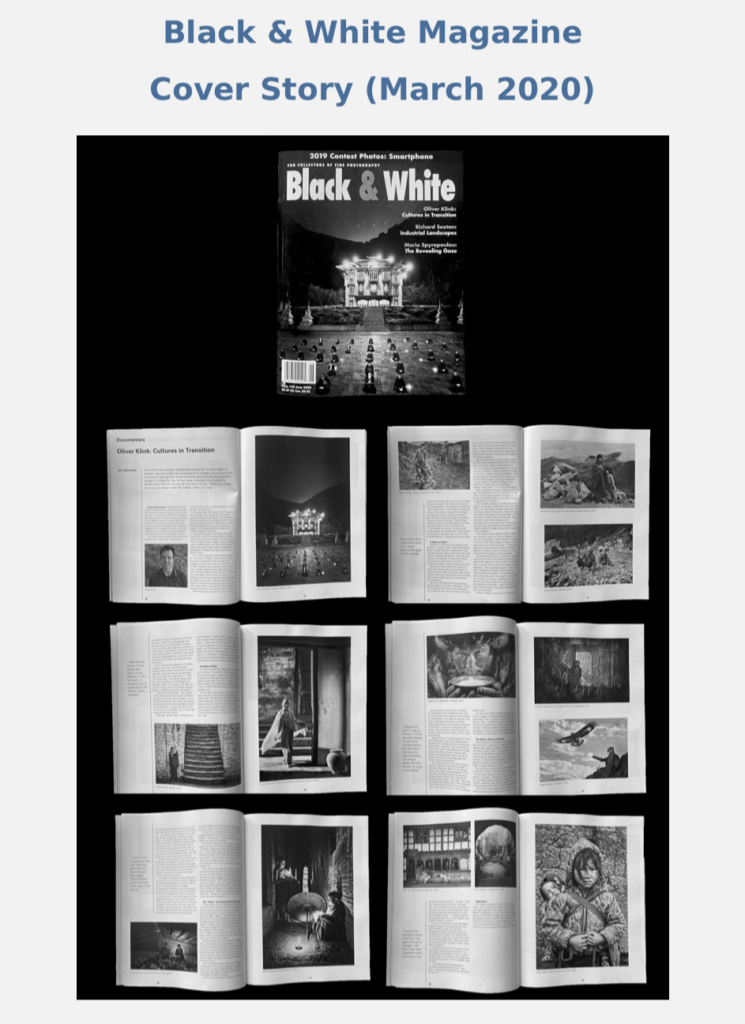
Cultures in Transition; 2018 – 2020 Retrospect
https://roblyimages.s3.amazonaws.com/accounts/9176/pdf/1997351.pdf
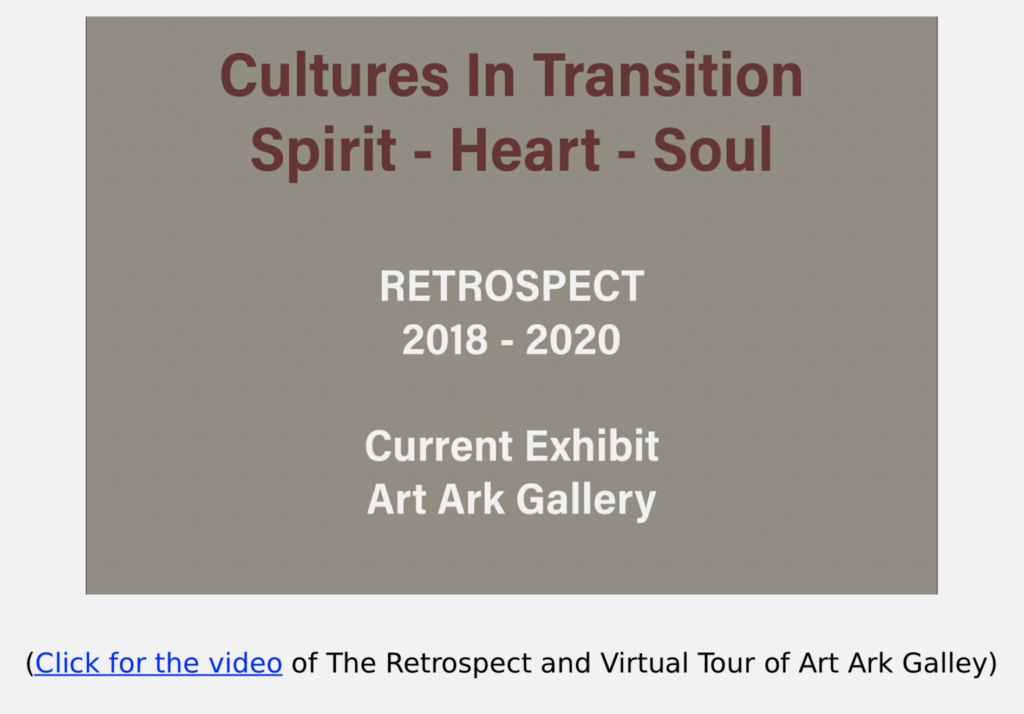
New Exhibit: Cultures in Transition Book at Davis Orton Gallery (New York) – Dec 7 – 22, 2019
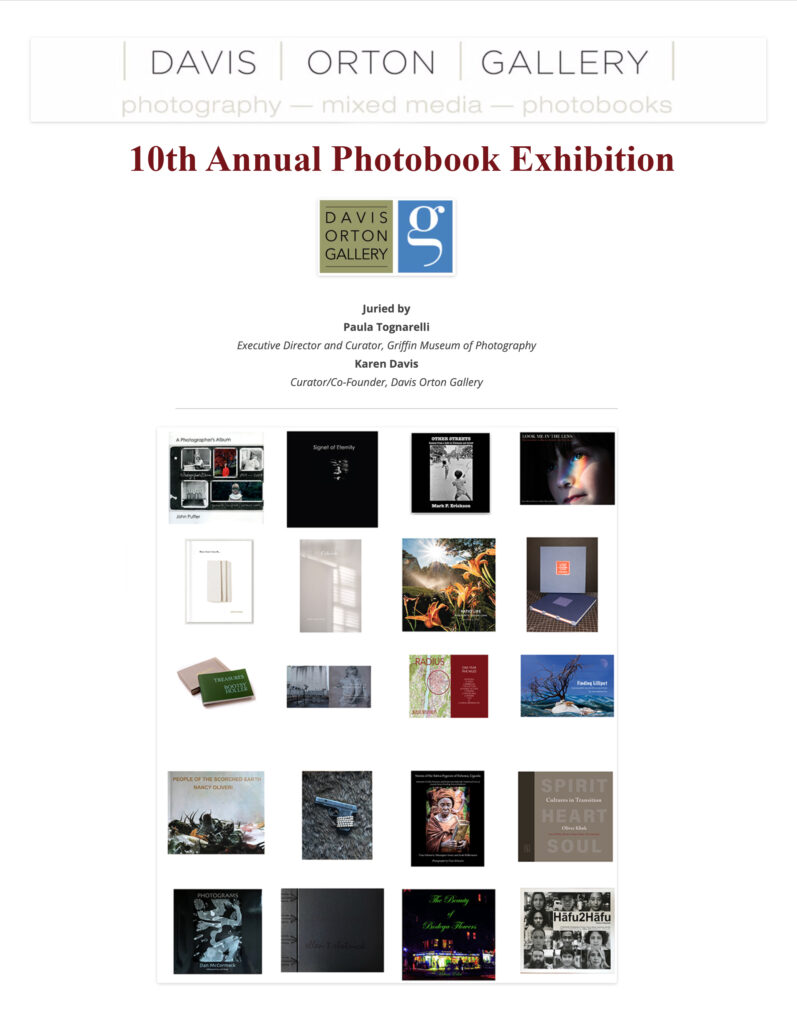
Don’t miss the opening reception of the 10th annual Photobook show at the Davis Orton Gallery in New York.
Date: Saturday, December 7, 2020
Time: 3 – 5PM
Location: 114 Warren Street, Hudson, NY 12534 – 518.567.4056
The books were selected by Paula Tognarelli, Executive Director and Curator, Griffin Museum of Photography & Karen Davis, Curator, Co-Founder, Davis Orton Gallery.
“Speaking for Paula and me, this show is always a delight to exhibit, with such a range of content, creative ideas and artistry.” Karen Davis.
Books are on display at the Davis Orton Gallery until December 22. The show will then travel to the Griffin Museum in 2020.
If you are in New York, stop by the Gallery, get your creative juice rolling, and collect incredible books.
Cultures in Transition Books are for sale at the Davis Orton Gallery or online. You can also pick up a copy (when in New York) at the ClampArt Gallery and ThrockMorton Gallery.
What a great way to start the holiday seasons!
About Cultures in Transition
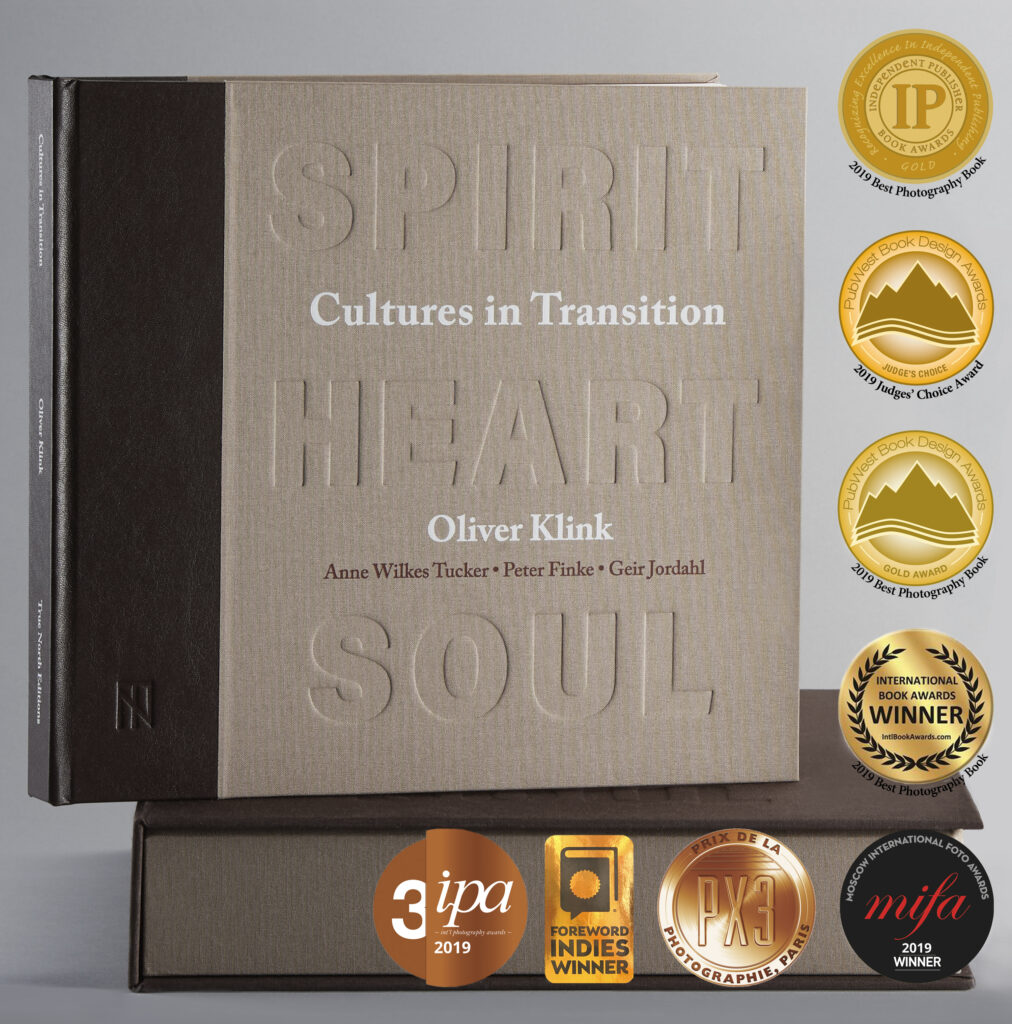
Over 15 years in five Asian countries (Bhutan, China, India, Myanmar, Mongolia), Klink explored the subtleties of people’s lives, their spiritual guiding light, the changes in the family nucleus, the resistance to stay autonomous, and the empowerment of women. Photographs are of exotic places and people, yet they connect deeply to what it means to be human. They are about survival. They are about the Spirit, Heart, and Soul in us all.
The book won eight awards for best photography book of 2019. The exhibit is printed with a process called Piezography. By using a combination of pigment ink and a proprietary profiling process I produce enhanced highlight and shadow details that exceed what is capable of using silver-based or platinum-based traditional darkroom processes.
#8 AWARD for Cultures in Transition Book: International Photography Awards

More information on the award and other winners can be found at http://www.photoawards.com/winner/
Book is for sale at https://www.culturesintransition.com/OrderForm
Congratulations to all … Oliver.
Cultures In Transition receives SEVEN AWARDS for Best photography book of 2019 (Design, Content, Print)

More information at www.culturesintransition.com
